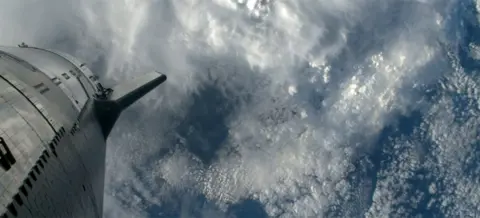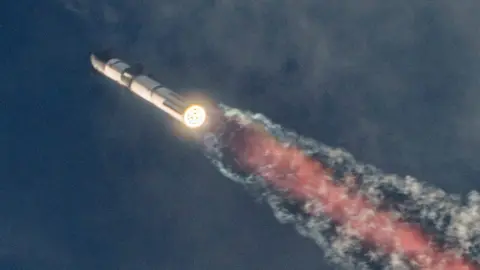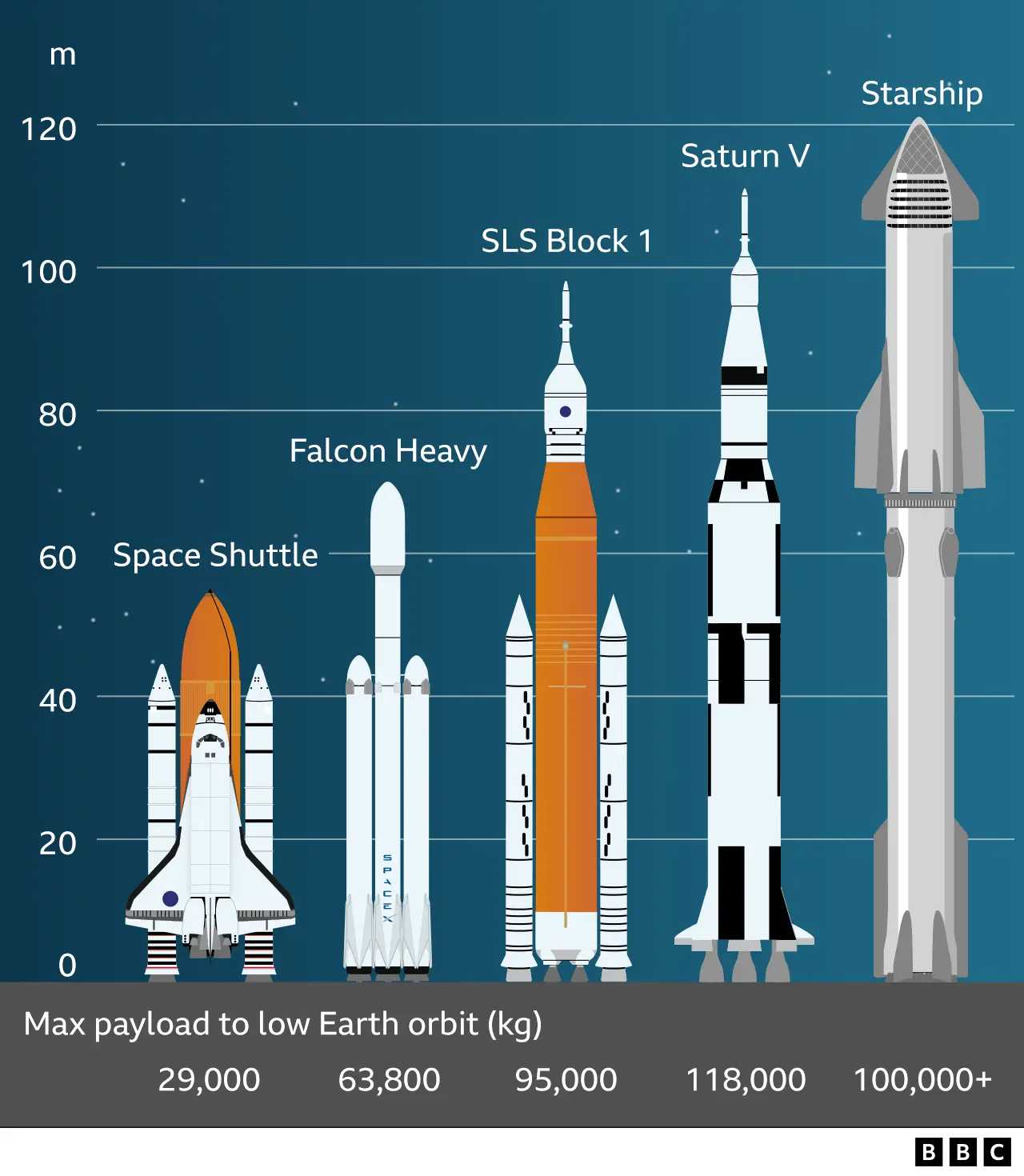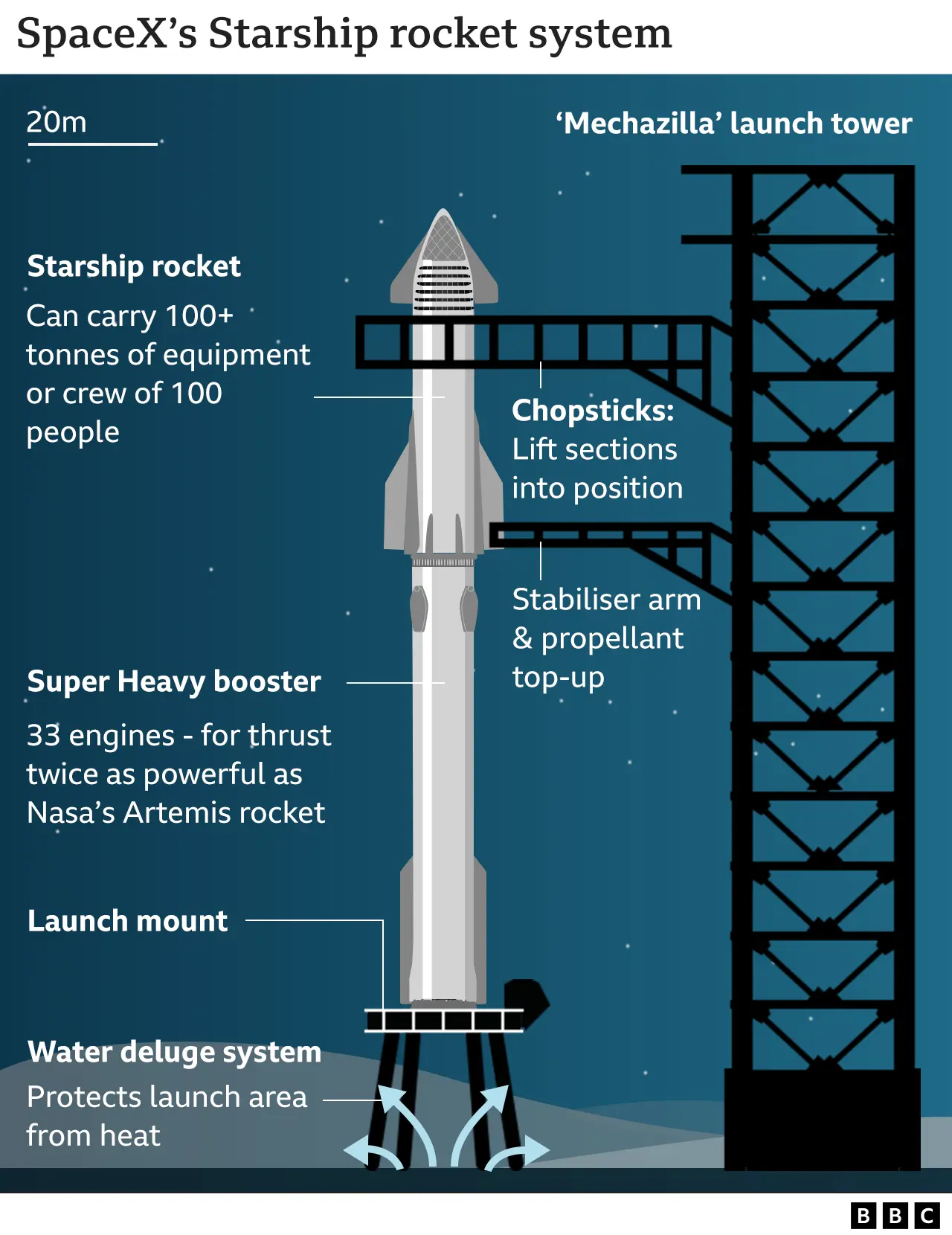International News
Elon Musk’s SpaceX Starship goes ‘farther than ever’

The two-stage vehicle made a perfect getaway from its Texas launch site, to send its upper portion around the globe to a re-entry over the Indian Ocean.
Radio contact was lost towards the end but the firm said it was “incredible to see how far we got this time around”.
SpaceX boss Elon Musk was delighted with the outcome of the flight, too.
He posted on X, formerly Twitter, that “Starship will take humanity to Mars”.
 Reuters
ReutersWhen the 120m-tall (395ft) vehicle launched in April and November last year, it blew apart not long into the mission.
Mr Musk was looking for significant improvement from his SpaceX team this time – and he got it.
The rocket left its launch mount with a huge rumble from its 33 engines, and the vehicle then proceeded to step perfectly through all of the anticipated phases in the climb to space.
Separation of the bottom half, the booster, from the top half, the Ship, occurred right on cue, two minutes and 44 seconds into the flight.
The ship then powered on, crossing the Atlantic and southern Africa.
Video cameras sent back spectacular views of Earth from more than 100 miles up.
 SpaceX
SpaceXThen came the task of re-entry, when the ship needed to descend to a splashdown in the ocean.
Video imagery captured incredible scenes as hot gases enveloped the vehicle, just before radio contact was interrupted.
Controllers reported shortly after that the Ship had been “lost”, presumably because it had broken up.
 SPACEX
SPACEXNot every milestone was ticked off. It was hoped the booster after separation might have been able to power its way back to a controlled drop into the sea just off the Texas coast. It got close but it looked as though the vehicle came in way too fast and hit the water very hard.
The Ship, too, was expected to re-ignite an engine to initiate the re-entry, but this was skipped for a reason not immediately apparent.
These are issues that can be re-visited once all the data is in hand. The upsum, however, is that engineers now know the development of the world’s most powerful rocket is firmly on track. And Elon Musk is promising perhaps six more test flights this year.
 Reuters
ReutersStarship is unlike any rocket system we’ve seen to date.
The 33 engines at the base of the booster produce 74 meganewtons of thrust. This dwarfs all previous vehicles, including those that sent men to the Moon in the 1960s/70s.
If engineers can perfect Starship, it will be revolutionary.
It’s intended to be fully and rapidly reusable, to operate much like an aeroplane that can be refuelled and put back in the air in quick order.
This capability, along with the heft to carry more than a hundred tonnes to orbit in one go, would radically lower the cost of space activity.

For Elon Musk, Starship is key to his Starlink project which is establishing a global network of broadband internet satellites. The current count in orbit is more than 5,500. The new rocket will be able to put up many more spacecraft for the network.
To that end, this test flight demonstrated the opening and closing of a payload bay door, through which future Starlink satellites could be dispensed.
And Starship will also help Mr Musk realise that long-held ambition of taking people and supplies to Red Planet to build a human settlement.

Among the keenest observers on Thursday will have been the US space agency.
Starship is central to Nasa’s Artemis programme to put astronauts back on the Moon this decade.
A version of Starship would act as the landing craft, taking the crew from lunar orbit down to the surface – and then lifting them back off again.
SpaceX will have to show it can produce a safe and reliable vehicle before astronauts are permitted to climb aboard. Nasa has scheduled late 2026 for when it would like to see this happen.
Bill Nelson, the Nasa Administrator, issued a statement on X: “Congrats to @SpaceX on a successful test flight! Starship has soared into the heavens. Together, we are making great strides through Artemis to return humanity to the Moon — then look onward to Mars.”
The Federal Aviation Administration, which licenses commercial spaceflight in the US, immediately announced there would be a mishap investigation following the mission, given the way the booster and Ship ended their flights. This is standard practice, and SpaceX will lead the inquiry into what it got right and what it got wrong. Again, standard practice.
International News
South African Online Casino Player Strikes Gold with R189,000 Win at Tusk Casino

JOHANNESBURG, South Africa 2024 — In a thrilling display of fortune and skill, Tusk Casino announces a monumental win by Adelheid, a passionate player from South Africa, who secured an astonishing R189,000 from a mere R100 bet on the renowned casino slot game, Gate of Olympus. This remarkable achievement underscores the high-stakes excitement that Tusk Casino offers to its players.
Adelheid’s journey to this significant win was facilitated by his engagement with SouthAfricanCasinos.co.za, the premier online casino and gambling guide specifically designed for South African players. Since its inception in 2003, SouthAfricanCasinos.co.za has been a cornerstone in the online gambling community, offering expert reviews, trustworthy recommendations, and the latest gambling news, thereby guiding players like Adelheid to reputable and enjoyable online gambling experiences.
“I’ve always looked for the best in online casinos, and SouthAfricanCasinos.co.za has never let me down,” Adelheid remarked. “Their insightful reviews and dependable advice led me to Tusk Casino, where I’ve not only found an incredible array of games but also this life-changing win. It’s a dream come true.”
Tusk Casino is renowned for its vast selection of over 3000 slot games, provided by world-leading game developers such as Pragmatic Play, Yggdrasil, and NetEnt. The casino distinguishes itself with generous bonus offerings, including a 50 Free Spins No Deposit On Wheel of Fortune on Registration, and a R5,000 Welcome Bonus for first-time deposits, making it an enticing choice for both new and seasoned players.
Adelheid’s win is a testament to Tusk Casino’s commitment to providing a premier online gaming experience in the South African market. The casino’s elegant design, user-friendly interface, and substantial bonuses are designed to engage and excite players, promising an unmatched online gaming journey.
With the support of SouthAfricanCasinos.co.za, Tusk Casino continues to solidify its position as a leading online gaming destination, offering secure, engaging, and lucrative gaming experiences for South African players. This partnership ensures that players have access to reliable information, the latest industry news, and the best online gambling opportunities, fostering a safe and enjoyable casino online gambling ecosystem.
About SouthAfricanCasinos.co.za
SouthAfricanCasinos.co.za stands as South Africa’s largest and most reliable online casino and gambling guide, delivering unparalleled casino recommendations, unbiased reviews, and comprehensive gambling insights tailored to ZAR casino players since 2003. It remains a crucial resource for players seeking secure, high-quality, and rewarding online gambling experiences.
About Tusk Casino
As an established corporation with numerous ground casinos worldwide, Tusk Casino has successfully extended its reach into the South African online casino market, offering an exquisite blend of stylish design, player-centric features, and significant bonuses. Licensed and regulated by the Government of Curacao, it provides a diverse range of over 3000 slot games from leading global providers, ensuring a rich, rewarding, and secure online gaming experience for all South African players. With its impressive bonuses and comprehensive payment support, Tusk Casino is dedicated to delivering a distinct and superior online gaming experience.
International News
US Based Nigerian Body Builder Michael Chidozie Shot Dead By Wife

HOUSTON, Texas | A woman (Keaiirra Shavoiyae Chidozie) is accused of shooting her husband several times during an argument in their apartment, once in the arm and again in the chest, according to court documents.
The Houston Police Department said officers responded to 2634 Yorktown Street at about 7:35 p.m. on Thursday and found a 26-year-old man shot in the bedroom.
He was taken to the hospital, where he was said to be in critical condition, according to police.
Detectives said that Chidozie and her husband were arguing when things escalated. Officers said her husband followed her into the bedroom and continued to argue before Chidozie grabbed a pistol and allegedly fired multiple shots in fear for her safety.
Police said they found Chidozie and their two children in a parking lot, where she was arrested.
The couple’s children are being cared for by a family member, according to police.
ALSO READ : Ngulube Raphael Sentenced to 26 Years for Abalone Trafficking, Haul Valued at Over R8 Million
The family of the late US-based Nigerian bodybuilder, Michael Chidozie has launched a GoFundMe account to raise $70,000 to bring his body to Nigeria for burial.
However, Ashley C who launched a GoFundMe account noted that it was always his dream to return to Nigeria one day and that they were committed to honouring his memory by fulfilling this final wish.
Ashley explained that the family was faced with the daunting task of laying Chidozie to rest in his homeland of Nigeria as well as legal matters that had arisen as a result of his untimely death.
Ashley said the expenses associated with repatriating Chidozie’s remains to Nigeria and organizing a proper funeral service exceed what his lone family member in the United States can manage alone.
Ashley’s message reads, “Dear Friends, Family, and Community, it is with heavy hearts that we come to you today to share the tragic news of the untimely passing of our beloved Chidozie Michael. On March 21st, 2024, Chidozie’s life was abruptly taken from us in a senseless act of violence.
“He was shot four times, sustaining a devastating spinal injury during an argument with his Houston native wife, Keaiirra Shavoiyae, in their own home. The presence of their two young sons, aged 3 and 2, during this horrifying incident has only added to the heartbreak of this situation.
“Chidozie fought courageously for his life, but unfortunately, he succumbed to his injuries in the early hours of April 9th, 2024. His passing has left a profound void in the lives of all who knew and loved him. He was a devoted father, a cherished son, and a dear friend to many. Chidozie’s kind heart, infectious laughter, and unwavering love for his family will forever be remembered and cherished by all who were fortunate enough to know him.
“As we navigate through this unimaginable loss, we are faced with the daunting task of laying Chidozie to rest in his homeland of Nigeria as well as legal matters that have risen as a result of this untimely passing. It was always his dream to return to Nigeria one day, and we are committed to honoring his memory by fulfilling this final wish.
“However, the expenses associated with repatriating Chidozie’s remains to Nigeria and organizing a proper funeral service exceed what his lone family member here in the United States can manage alone. Therefore, we are reaching out to our community, friends, and anyone touched by Chidozie’s story for support.
“Your generous contributions will directly contribute to covering the costs of transporting Chidozie’s body to Nigeria, arranging a dignified funeral service, legal services needed and providing support to his grieving family during this incredibly difficult time.
“We understand that times are tough for many, but no donation is too small. Every contribution, no matter how big or small, will make a significant difference in honoring Chidozie’s memory and providing closure for his loved ones.
“Let us come together as a community to give Chidozie the farewell he deserves and ensure that his legacy lives on in the hearts of those who knew and loved him.”
“Thank you for your kindness, generosity, and unwavering support during this incredibly challenging time,” it adds.ZIMETRO
Business News
Zim, Rwanda explore new areas of cooperation

The 3rd Rwanda-Zimbabwe Business Forum, which opened yesterday in Kigali, marks another significant milestone under the economic diplomacy as the Second Republic gears up efforts to unlock economic opportunities in Africa.
The high-level event, co-organised by ZimTrade and the Rwanda Development Board, brings together businesses, policymakers, and stakeholders from both countries to explore new avenues for collaboration and investment.
Head of Zimbabwean delegation to the forum, Foreign Affairs and International Trade Deputy Minister Sheillah Chikomo, said the programme provides practical solutions to explore in deepening cooperation between the two countries.
“This business forum will offer both countries an opportunity to forge new partnerships and attract foreign investment.
“The following few days will see us exploring more opportunities to delve deeper into practical actions that can be taken in various areas of cooperation including Government and private sector,” she said.
Deputy Minister Chikomo also indicated the importance of the previous programme in promoting exports and meeting national export growth targets.
“In 2023 we achieved US$7.6 billion in exports of goods and services which was 5,2 percent above the targeted US$7.22 billion.
“The increase in exports between Zimbabwe and Rwanda since the beginning of our coordinated efforts in 2021 also contributed to this growth.
“Zimbabwe’s ability to surpass the targeted export figures is a reflection that goes to show how initiatives such as this one can boost trade,” said Deputy Minister Chikomo.
Rwanda Minister of Foreign Affairs and International Cooperation, Mr Vincent Biruta, said the business forum represents the deepening relations between Rwanda and Zimbabwe.
“Your presence here today signifies the deepening of our bilateral relations and the commitment to foster greater economic cooperation between our two nations. In recent years, we have witnessed a notable increase in economic collaboration between Rwanda and Zimbabwe.
“We must seize the occasion this forum presents to foster strategic economic partnerships that will benefit our respective people,” he said.
Mr Biruta also said it is important for the two countries to leverage on areas they enjoy competitive advantages.
“Rwanda and Zimbabwe share a common will for inclusive growth, sustainable development, and entrepreneurship.
“By working together we can unlock new opportunities, accelerate investment flows, and create an environment for businesses to thrive.
“As we navigate a complex global landscape, it is essential to identify and capitalise on emerging trends and market dynamics.
“Rwanda and Zimbabwe, with their unique strengths and capabilities, have much to offer the world. Leveraging our respective comparative advantages, we can create a cycle of growth and prosperity that benefits both nations”, said Mr Biruta. ZimTrade CEO, Allan Majuru said Rwanda presents several opportunities for Zimbabwean businesses and urged companies to take full advantage of business linkages platforms available during the Forum.
Source: Herald

